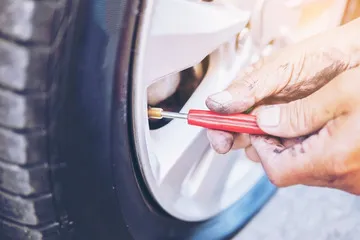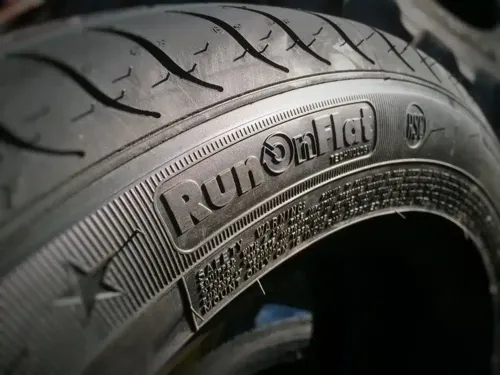What is tyre sealant?
Everything you need to know about tyre sealant, and how it works.
Posted on

Tyre sealant is a popular solution for dealing with unexpected punctures and flat tyres. Whether you’ve experienced a slow leak or a sudden puncture, tyre sealant can temporarily fix the problem and get you back on the road. But how does tyre sealant work, and when should you use it?
In this blog post, we’ll explain what tyre sealant is, how it works, its benefits, and when it’s appropriate to use, so you can decide if it’s the right choice for your tyre emergency.
What is Tyre Sealant?
Tyre sealant is a liquid compound that’s designed to temporarily seal small punctures or leaks in your tyre. It is typically made of a sticky, latex-based substance that hardens when it comes into contact with air, creating a seal around the puncture. The sealant is usually injected into the tyre via the valve, allowing it to spread throughout the interior and fill the hole or leak.
There are two main types of tyre sealants:
- Pre-installed sealants: These are applied in the tyre during manufacturing or can be installed before a puncture happens. They remain inside the tyre and act immediately when a puncture occurs.
- Emergency tyre sealants: These are designed to be used after a puncture has already happened. Drivers can carry a bottle of emergency tyre sealant in their vehicle and use it when needed.
How Does Tyre Sealant Work?
The process is fairly straightforward. When you inject tyre sealant into a punctured tyre, the liquid spreads inside the tyre as it rotates. As it reaches the puncture or leak, the sealant reacts with the air, solidifying and plugging the hole. The tyre sealant essentially “patches” the inside of the tyre to prevent further air from escaping.
Tyre sealants can seal small holes, typically up to 6mm in diameter, but they are not a permanent fix. Once the sealant is applied, you should visit a professional to have the tyre properly repaired or replaced.
When to Use Tyre Sealant
Tyre sealant is ideal for emergency situations when you need a quick temporary fix to get back on the road. It can be especially useful in the following scenarios:

- Sudden punctures: If you experience a puncture on the road and don’t have immediate access to a spare tyre, tyre sealant can help you safely continue driving to the nearest repair shop.
- Slow leaks: Tyre sealant can also work for slow leaks that may not require immediate attention but still need a temporary solution.
- Remote locations: If you’re driving in a remote area without nearby help or a service station, tyre sealant can provide a quick solution until you can get proper assistance.
The Benefits of Tyre Sealant
There are several advantages to using tyre sealant, especially in emergency situations:
1. Convenience
One of the biggest benefits of tyre sealant is its convenience. It’s easy to carry in your vehicle, and applying it is usually simple and doesn’t require special tools. With a bottle of tyre sealant, you can quickly patch up a small puncture and be on your way.
2. Saves Time
Instead of waiting for roadside assistance or changing a flat tyre, you can apply tyre sealant and continue driving. This can save you valuable time, especially when you’re on a busy schedule.
3. Temporary Fix
If you’re stuck on the road and don’t have a spare tyre, sealant offers a temporary fix that allows you to get to a service station or tyre shop for a proper repair. This can prevent you from being stranded on the roadside.
4. Easy to Use
Using tyre sealant is simple. Most products come with clear instructions, and you don’t need to be an expert to apply it. The sealant is injected into the tyre via the valve, and in a matter of minutes, your tyre is temporarily sealed.
Limitations of Tyre Sealant
While tyre sealant can be a lifesaver in emergencies, it’s important to understand its limitations:
1. Temporary Solution
Tyre sealant is designed to be a temporary fix, not a permanent solution. While it can get you back on the road, you should always seek professional tyre repair as soon as possible after using sealant. The sealant can only fix small punctures, and larger holes or sidewall damage will require a more comprehensive repair.
2. May Affect Tyre Sensors
In vehicles with Tyre Pressure Monitoring Systems (TPMS), using tyre sealant can sometimes interfere with the sensors. The sealant might clog the sensor, causing it to malfunction or provide inaccurate readings. If your car has TPMS, check if the tyre sealant you’re using is compatible with it.
3. Not Suitable for All Punctures
Tyre sealant works best for small punctures, typically less than 6mm in diameter. Larger punctures, gashes, or sidewall damage cannot be repaired with sealant. Additionally, tyre sealant isn’t effective for repairing slow leaks caused by worn-out valves or significant structural damage to the tyre.
4. Limited Driving Distance
After using tyre sealant, you should only drive for a limited distance — usually between 50 to 100 miles—before seeking professional help. The sealant is a temporary patch and is not designed for long-term use.
How to Use Tyre Sealant
If you’re faced with a puncture and need to use tyre sealant, follow these simple steps to apply it:
- Position the vehicle safely: Move your vehicle to a safe location, away from traffic, and switch on your hazard lights.
- Remove the valve cap: Unscrew the valve cap from the tyre’s valve stem.
- Attach the sealant: Connect the sealant nozzle to the valve stem, making sure it’s tightly attached.
- Inject the sealant: Squeeze or pump the sealant into the tyre as per the product’s instructions. Make sure the tyre rotates slightly to distribute the sealant inside.
- Reinflate the tyre: Use an air pump to inflate the tyre to the recommended pressure.
- Drive to distribute the sealant: After inflating the tyre, drive slowly for a few minutes to allow the sealant to spread and fully seal the puncture.
Remember, tyre sealant is a temporary solution, so make sure to get the tyre professionally checked and repaired as soon as possible.
Is Tyre Sealant Right for You?
If you frequently drive in remote areas or on roads prone to debris, carrying tyre sealant can be a practical addition to your emergency kit. While it’s not a substitute for regular tyre maintenance or a spare tyre, it can provide peace of mind in emergencies and help you avoid being stranded.










